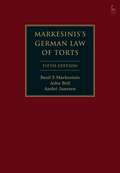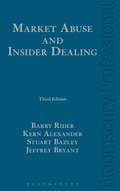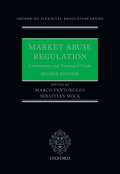- Table View
- List View
Mark Felt: The Man Who Brought Down the White House
by Mark Felt John O'ConnorNOW A MAJOR MOTION PICTURE starring Liam Neeson.The covert Watergate whistleblower tells the story of the dramatic showdown between the FBI and the Nixon White HouseIn the 1970s, Mark Felt was given the code name "Deep Throat" and shared intelligence on the Watergate break-in with a young reporter from the Washington Post named Bob Woodward. Thus began the greatest political scandal in the twentieth century, which would besmirch an entire administration and bring down a presidency.A patriotic man, Felt only revealed his role in our national history as he neared the end of his life. Based on his personal recollections, Mark Felt chronicles his FBI career, from the end of the great American crime wave and World War II to the culture wars of the 1960s and his penetration of the Weather Underground; provides rich historical and personal context for his role in the Watergate scandal; and depicts how he came to feel that the FBI needed a "Lone Ranger" to protect it from White House corruption.
The Mark of the Sacred (Cultural Memory in the Present)
by Jean-Pierre DupuyJean-Pierre Dupuy, prophet of what he calls "enlightened doomsaying," has long warned that modern society is on a path to self-destruction. In this book, he pleads for a subversion of this crisis from within, arguing that it is our lopsided view of religion and reason that has set us on this course. In denial of our sacred origins and hubristically convinced of the powers of human reason, we cease to know our own limits: our disenchanted world leaves us defenseless against a headlong rush into the abyss of global warming, nuclear holocaust, and the other catastrophes that loom on our horizon. Reviving the religious anthropology of Max Weber, Emile Durkheim, and Marcel Mauss and in dialogue with the work of René Girard, Dupuy shows that we must remember the world's sacredness in order to keep human violence in check. A metaphysical and theological detective, he tracks the sacred in the very fields where human reason considers itself most free from everything it judges irrational: science, technology, economics, political and strategic thought. In making such claims, The Mark of the Sacred takes on religion bashers, secularists, and fundamentalists at once. Written by one of the deepest and most versatile thinkers of our time, it militates for a world where reason is no longer an enemy of faith.
Marked For Life (Mira Ser.)
by Emelie ScheppWINNER OF THE SPECSAVERS READERS CHOICE AWARD 2016 In Lindö, on the Swedish coast, a man has been found brutally murdered in his own home.
Markenaudit für Kulturinstitutionen: Ganzheitliches Tool zur Analyse und Professionalisierung der Markenführung im Kultursektor (Kunst- und Kulturmanagement)
by Carsten Baumgarth Marina Kaluza Nicole LohrischMarken sind ein effektives, aber immer noch mit Argwohn beäugtes und häufig unprofessionell umgesetztes Konzept im Kulturbereich. Ein „Markenaudit für Kulturinstitutionen“ kann dazu beitragen, die Professionalität der Markenführung von Kulturinstitutionen nachhaltig zu verbessern und dadurch auf dem Besuchermarkt erfolgreicher zu sein. Dazu präsentiert das Buch neben den Grundlagen zur Markenführung im Kultursektor und zu Markenaudits das Tool MAK. Dieses beurteilt ganzheitlich mit Hilfe von 83 Indikatoren die Marke einer Kulturinstitution. Das Buch beschreibt das zugrundeliegende Markenmodell (inkl. 15 Best-Practices) sowie alle für die praktische Durchführung des MAKs notwendigen Schritte. Die Darstellung der methodischen Qualität des MAKs sowie eines verkürzten Ansatzes zur Selbstevaluation der eigenen Marke runden das Buch ab.
Markenpiraterie: Erscheinungsformen, strafrechtliche Bekämpfung und zivilrechtliche Ansprüche (Reihe Rechtswissenschaft ab Bd. 209 #220)
by Karolina M. PekalaDie in der nationalen Zollstatistik seit 1995 erfasste Markenpiraterie hat sich in den vergangenen Jahrzehnten zu einem kriminellen Massenphänomen mit mafiaähnlichen Strukturen entwickelt, was nicht zuletzt auf den wirtschaftlichen Aufschwung in Asien und insbesondere auf die Öffnung Chinas gegenüber dem Westen zurückzuführen ist. Hatte der Zoll 1995 noch 506 sogenannter Aufgriffe, stieg die Zahl im Jahr 2005 auf 7217 und dann 2010 und 2011 auf die beeindruckende Zahl von jeweils 23.500 Fälle. Spektakulär war die Beschlagnahme von Containern im Jahr 2006 durch Hamburger Zollbeamte mit über einer Million gefälschter Adidas, Nike und Puma Sportschuhe.Das kriminelle Fälschen von Markenwaren hat nicht lediglich für Unternehmen und Markeninhaber selbst Folgen, wie insbesondere Gewinneinbußen und Rufschäden. Auch die getäuschten Verbraucher werden geschädigt, nicht nur materiell, sondern in manchen Fällen auch in ihrer Gesundheit. Imitierte Markenkleidung kann aufgrund minderwertiger Stoffen Allergien auslösen; gefälschte Arzneimittel können sogar lebensbedrohliche Folgen haben. Daneben ist die Volkswirtschaft allgemein betroffen, etwa durch Arbeitsplatzverluste.Ein umfangreicher, praxisrelevanter Teil der Darstellung informiert über Täter, Herkunftsländer, Vorgehensweisen und die vorzugsweise gefälschten Markenprodukte sowie die Praxis der Aufklärung, Beschlagnahme und Vernichtung gefälschter Waren. Dabei geht es um das Tätigwerden des Zolls, der insoweit polizeiliche Aufgaben wahrnimmt, sowie der Staatsanwaltschaften und Strafgerichte, aber auch von Rechtsanwälten betroffener Unternehmen.Das Buch hat das Ziel das Phänomen der Markenpiraterie aus Sicht der Markeninhaber, aber auch der Verbraucher, möglichst umfassend zu untersuchen und nach effektiven Bekämpfungsmöglichkeiten zu fragen. Es richtet sich insbesondere an die Hersteller und Vertreiber von Markenwaren, Juristen, Zollbeamte, die im Bereich des Gewerblichen Rechtsschutzes tätig sind, sowie interessierte Studenten und Verbraucher.
Markesinis And Deakin's Tort Law (PDF)
by Simon Deakin Zoe AdamsNow in its eighth edition Markesinis and Deakin's Tort Law provides a general overview of the law and full discussion of the academic debates on all major topics, highlighting the relationship between the common law, legislation, and judicial policy. In addition, the authors provide a variety of comparative and economic perspectives on the law of tort and its likely development, always placing the subject in its socio-economic context thereby giving students a deeper and richer understanding of tort law. This detailed and authoritative book offers teachers a wide range of topics to cover, while providing students with a text which is both descriptive and reflective of this branch of law.
Markesinis & Deakin's Tort Law
by Simon Deakin Zoe AdamsNow in its eight edition, Markesinis and Deakin's Tort Law provides a general overview of the law and full discussion of the academic debates on all major topics, highlighting the relationship between the common law, legislation, and judicial policy. In addition, the authors provide a variety of comparative and economic perspectives on the law of tort and its likely development, always placing the subject in its socio-economic context thereby giving students a deeper and richer understanding of tort law. This detailed and authoritative book offers teachers a wider range of topics to cover, while providing students with a text which is both descriptive and reflective of this branch of law. Digital formats This eighth edition is available for students and institutions to purchase in a variety of formats. - The e-book offers a mobile experience and convenient access along with functionality tools, navigation features, and links that offer extra learning support: www.oxfordtextbooks.co.uk/ebooks
Markesinis's German Law of Torts
by Basil S Markesinis John Bell André JanssenSince its first appearance in 1986, this magisterial work has won uniform praise from many of the world's leading comparatists. It has been acclaimed by senior judges and has been cited by the courts of many countries. This new, substantially rewritten and systematically updated fifth edition of the work, contains over 95 leading judgments, most translated in their entirety, along with references to over 2,000 other decisions from Germany and the common law world. While the book remains an ideal tool for teaching comparative torts and comparative methodology, the fact that it has been extensively rewritten makes it an indispensable source of inspiration for those with a professional interest in tort litigation and tort law reform. This edition has paid particular attention to liability for internet activity, medical liability and the protection of personality rights and private life.
Markesinis's German Law of Torts
by Basil S Markesinis Professor John Bell André JanssenSince its first appearance in 1986, this magisterial work has won uniform praise from many of the world's leading comparatists. It has been acclaimed by senior judges and has been cited by the courts of many countries. This new, substantially rewritten and systematically updated fifth edition of the work, contains over 95 leading judgments, most translated in their entirety, along with references to over 2,000 other decisions from Germany and the common law world. While the book remains an ideal tool for teaching comparative torts and comparative methodology, the fact that it has been extensively rewritten makes it an indispensable source of inspiration for those with a professional interest in tort litigation and tort law reform. This edition has paid particular attention to liability for internet activity, medical liability and the protection of personality rights and private life.
Market Abuse and Insider Dealing: (third Edition)
by Barry Rider Kern Alexander Stuart Bazley Jeffrey BryantMarket Abuse and Insider Dealing, 3rd edition provides a comprehensive exposition of the law of insider dealing and market abuse, including analysis of the interplay between UK Criminal law and Administrative law regulation of abusive behaviour in the UK financial markets.The title covers areas including:Insider dealing – the civil law;The main offences for insider dealing;Market abuse – regulatory discipline and the civil law;Fraud offences as they relate to market abuse;Money laundering and market abuse;Conflicts of interest;The liability of issuers of securities in respect of disclosure and inside information;Information gathering, market surveillance, investigations and enforcement;Compliance systems and controls and control liability.Includes the following legislation and case law:Financial Services Act 2012;New Financial Conduct Authority;New EU Market Abuse Regulation;MiFID II (Markets in Financial Instruments Directive).
Market Abuse and Insider Dealing
by Barry Rider Kern Alexander Stuart Bazley Jeffrey BryantMarket abuse and insider dealing remains and always has been a real concern for all those that operate in the financial sector. Some of the earliest laws relating to trade outlaw attempts to artificially interfere with the proper functions of the markets and ensure fairness.With recent changes to both the UK and European regimes the line between what is normal (and sensible) business practice and what may now be classified as market abuse is becoming increasingly fine. This raises questions about communications between financial institutions and investors, and about corporate and analyst access. Market Abuse and Insider Dealing provides guidance on and explanation of the range of potential legal and regulatory responses to this complex area of law.Providing a thorough analysis and assessment of the law relating to market abuse and insider dealing, the new fourth edition includes:- analysis of the impact of Brexit- significant new case law and legislation including MiFID II; Money Laundering Regulations 2017; the Money Laundering, Terrorist Financing and Transfer of Funds (Information on the Payer) Regulations 2017; Criminal Finances Act 2017 with Unexplained Wealth Orders; The Fifth Money Laundering Directive - the new Corporate Governance Code - new content on: control and senior managers' responsibility/liability; the FCAs competition law jurisdiction where it is appropriate to do so in relation to market abuse; a new table of UK decided market abuse cases
Market Abuse Regulation: Commentary and Annotated Guide (Oxford EU Financial Regulation)
by Marco Ventoruzzo, Sebastian MockNow a volume in the Oxford EU Financial Regulation Series, the second edition of Market Abuse Regulation has been updated to reflect the impact of a number of major developments in legislation and case law following the implementation of the EU Market Abuse Regulation (MAR). Written by leading scholars in the field of capital markets law from a number of European jurisdictions, the book is divided into two main parts. The first consists of chapters considering relevant issues by topic, including aspects not directly addressed by MAR such as enforcement, and the impact of US securities regulation. The second part provides article-by-article commentary on the Regulation, with a detailed and technical analysis of its terms. Both parts have been updated to reflect important developments such as amendments to directives and new regulations regarding the promotion of the use of SME growth markets. The second edition includes additional chapters on sanctions. One new chapter deals exclusively with the criminal sanctions (including CRIM-MAD), and another addresses in much greater detail private enforcement in key jurisdictions (France, Germany, Italy, the Netherlands and Spain), which is neither addressed by the MAR nor harmonized by other European legislation. This chapter on private enforcement is also accompanied by another dealing with aspects of private international and international civil procedural law. The existing chapters have also been updated to bring them fully up to date.
Market Abuse Regulation
by Edward J Swan John VirgoMarket Abuse Regulation is a wide-ranging and insightful analysis of the market abuse regime and the applications of the regulations in the UK and European Union. It provides detailed discussion of the implementation and interpretation of the regulation, the conduct of investigations, the defences and appeals available against a finding of market abuse, and overlapping United States regulation. The new edition explains and evaluates the changes introduced by the Markets in Financial Instruments Directive , the Market Abuse Directive, the Market Abuse Regulation, and the implementation of the Regulation on Wholesale Market Integrity and Transparency, which have resulted in dramatic expansion of the coverage of EU market abuse regulation. It addresses the regulation of additional financial instruments, the expansion to include new markets and trading facilities, and changes to the coverage of commodity derivatives and physical commodities. It discusses the dramatic changes to the format of regulation as a result of the restructuring of UK regulators; as well as the addition of new EU supervisory bodies with revised powers over national regulation within the EU. Beyond the EU, it discusses international protocols and treaties which have also added to the regulatory structure.
Market Abuse Regulation
by Edward J Swan John VirgoMarket Abuse Regulation is a wide-ranging and insightful analysis of the market abuse regime and the applications of the regulations in the UK and European Union. It provides detailed discussion of the implementation and interpretation of the regulation, the conduct of investigations, the defences and appeals available against a finding of market abuse, and overlapping United States regulation. The new edition explains and evaluates the changes introduced by the Markets in Financial Instruments Directive , the Market Abuse Directive, the Market Abuse Regulation, and the implementation of the Regulation on Wholesale Market Integrity and Transparency, which have resulted in dramatic expansion of the coverage of EU market abuse regulation. It addresses the regulation of additional financial instruments, the expansion to include new markets and trading facilities, and changes to the coverage of commodity derivatives and physical commodities. It discusses the dramatic changes to the format of regulation as a result of the restructuring of UK regulators; as well as the addition of new EU supervisory bodies with revised powers over national regulation within the EU. Beyond the EU, it discusses international protocols and treaties which have also added to the regulatory structure.
Market Abuse Regulation: Commentary and Annotated Guide (Oxford EU Financial Regulation)
Now a volume in the Oxford EU Financial Regulation Series, the second edition of Market Abuse Regulation has been updated to reflect the impact of a number of major developments in legislation and case law following the implementation of the EU Market Abuse Regulation (MAR). Written by leading scholars in the field of capital markets law from a number of European jurisdictions, the book is divided into two main parts. The first consists of chapters considering relevant issues by topic, including aspects not directly addressed by MAR such as enforcement, and the impact of US securities regulation. The second part provides article-by-article commentary on the Regulation, with a detailed and technical analysis of its terms. Both parts have been updated to reflect important developments such as amendments to directives and new regulations regarding the promotion of the use of SME growth markets. The second edition includes additional chapters on sanctions. One new chapter deals exclusively with the criminal sanctions (including CRIM-MAD), and another addresses in much greater detail private enforcement in key jurisdictions (France, Germany, Italy, the Netherlands and Spain), which is neither addressed by the MAR nor harmonized by other European legislation. This chapter on private enforcement is also accompanied by another dealing with aspects of private international and international civil procedural law. The existing chapters have also been updated to bring them fully up to date.
Market Access of Traditional Chinese Medicinal Product in the EU under WTO Legal Framework (Economic and Financial Law & Policy – Shifting Insights & Values #5)
by Saisai WangThis book presents an in-depth analysis of issues in trade law and EU pharmaceutical law concerning market access for traditional Chinese medicinal products. It discusses these issues from the standpoints of fundamental law, international law and EU law, so to offer a comprehensive perspective. Specifically, it points out the core legislative issues for EU policymakers who deal with market access for traditional medicinal products; describes the relation between law and science; and offers essential information on herbal medicinal product registration in the EU. Further, it compares EU law and Chinese law in this regard, which can offer inspirations for readers from other counties that have similar medicinal products. The book uses straightforward, accessible language to break down the key issues involved.
Market and Competition Authorities: Good Agency Principles
by Annetje OttowMarket and competition authorities operate in a complex environment with conflicting stakeholder demands. Balancing the various interests of the authority and stakeholder in an objective and impartial manner is strategic to achieving the goals of the legislation imposed. In a fresh approach examining the actions of an authority when a regulation is applied, Annetje Ottow argues the vital importance of the behaviour of authorities, focusing on five fundamental good agency principles: legality, independence, transparency, effectiveness, and responsibility, or, LITER. These principles provide agencies and those reviewing their actions with a framework for agency design and action. Combining theory and practice to provide insight into agencies' organization and behaviour, this book outlines and analyses behavioural issues using an ecosystemic method, addressing how independent agencies should be assessed, and which principles should apply. Using cases from the Netherlands and the UK, Ottow examines the key processes of authorities against the LITER principles, and opens the debate on 'how to regulate the agency'.
Market and Competition Authorities: Good Agency Principles
by Annetje OttowMarket and competition authorities operate in a complex environment with conflicting stakeholder demands. Balancing the various interests of the authority and stakeholder in an objective and impartial manner is strategic to achieving the goals of the legislation imposed. In a fresh approach examining the actions of an authority when a regulation is applied, Annetje Ottow argues the vital importance of the behaviour of authorities, focusing on five fundamental good agency principles: legality, independence, transparency, effectiveness, and responsibility, or, LITER. These principles provide agencies and those reviewing their actions with a framework for agency design and action. Combining theory and practice to provide insight into agencies' organization and behaviour, this book outlines and analyses behavioural issues using an ecosystemic method, addressing how independent agencies should be assessed, and which principles should apply. Using cases from the Netherlands and the UK, Ottow examines the key processes of authorities against the LITER principles, and opens the debate on 'how to regulate the agency'.
Market Definition in EU Competition Law (New Horizons in Competition Law and Economics series)
by Miguel S. FerroThe maintenance of a fair, competitive market among member states is critical to the functioning of the EU economy. In this book, the first comprehensive, unifying view of market definition, Miguel Ferro adeptly explores the different economic-legal issues that arise in EU competition law. Featuring an exhaustive analysis of European case law, this astute work provides a succinct and nuanced guide to market definition within a variety of markets and contexts. Insightful and timely, it explores the different economic-legal issues that arise in European case law, distinguishing economic debates from the legal issues involved. In so doing, it seeks to prevent the distortions to the legal method that can result from adopting a more piecemeal approach. Market Definition in EU Competition Law provides a crucial introduction to the topic and will be an important resource for students and scholars of European competition law. Practitioners and judges will also benefit from the extensive analysis of case law and the practical examples.
Market Design Powers of the European Commission?: Remedies under Articles 7 and 9 Regulation 1/03 (Munich Studies on Innovation and Competition #13)
by Korbinian ReiterThis book provides a comprehensive analysis of the remedies practice the European Commission has adopted on the basis of articles 7 and 9 of regulation 1/03. Using article 7 as a normative benchmark, it shows that most of the criticism levelled at the Commission's article 9 decisions and the Alrosa judgment of the CJEU is not justified, since critics tend to over-state both the rigour of article 7 and the laxness of article 9. Remaining inconsistencies between the commitment practice and the standards for infringement decisions can, it is submitted, be justified by the consensual nature of commitment decisions and their underlying goal of procedural economy. Moreover, it is suggested that too little importance is generally assigned to the beneficial effect which commitments bring about by providing for precise and enforceable obligations without sacrificing the concerned undertakings’ freedom to choose how to put the infringement to an end. Adopting a case-oriented approach, this study provides valuable insights for academics and practitioners alike.
The Market Economy as a Social System
by Hiroto TsukadaThis book develops John Rawls’s theory of justice by adding reality-based analyses. This is accomplished by answering the question of who makes rules and how, and by providing new answers to three of today’s most practical and critical issues. The question of who and how makes rules is discussed first; and group orientation instead of individualism, and a balance of negotiating power instead of a veil of ignorance are presented as new answers to this question. Based on this new understanding of rulemaking, three important practical rules are subsequently discussed: the rule of distribution of land and other natural resources, including the question of natural talent or who should bear the costs of children’s education; the rule of distribution of products; and what motives support our acts of kindness. These rules are all dealt with from a shared perspective, viewing society as a single integrated construct. Equal distribution of land, not private but public payment of education fees, strengthening employees’ bargaining power, and moving toward nobility-based kindness are put forward as central answers. By addressing critical questions on social rules and proposing answers, this book provides reliable principles to fall back on in our daily lives, and in our rapidly changing, globalized world.
The Market Economy Investor Test in EU State Aid Law: Applicability and Application
by Małgorzata CyndeckaFor upwards of thirty years EU and EFTA courts have been using a test for applying the Market Economy Investor Principle (MEIP) 10 determine whether a state intervention amounts 10 granting of an economic advantage 10 a recipient undertaking. If the stale wishes 10 set as a commercial operator, it must comply with the MEIP. Unsurprisingly, the test remains a difficult and controversial legal instrument, and its very existence and credibility have been questioned. This book unravels the nation of the MEIP, analysing its applicability in order 10 clarify doubts and misinterpretations. Such an understanding is crucial because of the negative consequences of the test's misapplication, and also because the ongoing process of opening markets for more competition blurs the distinction between the public and private sectors. The analysis addresses such questions as the following; - What characterizes a 'prudent' investor? - When is it justified to consider a given public investor 'rational' or 'reasonable'? - How should too 'economic' or 'commercial soundness' of state interventions be understood? - What rate of return is required under the MEIP and how is it calculated? - When should the profitability analysis be undertaken and why? The author examines both the theory behind too principle and its practical application, with detailed attention to case law and the Commission's guidelines explaining the test's mechanism. Soo considers the various critiques of the test and concludes with proposals for change. Practitioners, policymakers, and academics will appreciate the great clarification offered of too MEIP - the character of an economic advantage under the MEIP and in aid scenarios, how to determine whether the MEIP is applicable 10 a given state measure, and how 10 apply the test according 10 its various subtypes and to atypical or complex interventions. They will find that too book's systematic analysis goes a long way to ensuring a credible and reliable assessment of the applicability of state aid under Article 107(1) TFEU.
Market Entry and Competition Law in Latin America: The Role of Economic Development in Antitrust Analysis (Munich Studies on Innovation and Competition #14)
by Francisco Eduardo Beneke AvilaThis book explores the relationship between market entry analysis in competition law and the study of the determinants of aggregate investment. Macroeconomic and social characteristics, such as widespread corruption, political instability, and low levels of education are associated with lower investment rates. Progress on these indicators on the other hand is also strongly associated with sustained growth and higher investment rates. This book analyzes the interaction between these macro variables and the market-specific analysis typical in antitrust cases. Against this background, representative decisions of four Latin American competition authorities – México, El Salvador, Colombia, and Chile – on unilateral conduct are analyzed, focusing on market power assessment. The analysis shows that there is little to no explicit or implicit consideration of the impact of the macroeconomic environment on market dynamism and therefore on market power. This book also explores the influence that EU and US competition law have in the standards to prove ease of market entry developed by the Latin American authorities. Although most of the Latin American authorities share a lack of reliance on market forces, which is characteristic of EU competition law, this book argues that market entry analysis still needs to be adjusted to fit the socio-economic context that affects investment within the country and the degree to which each particular market is affected. Finally, the book proposes a framework on how the macro characteristics covered can be incorporated into competition law enforcement.
Market, Ethics and Religion: The Market and its Limitations (Ethical Economy #62)
by Niels KærgårdThis book deals with the basic question of what money can and cannot buy and offers an analysis of the limitations of the market mechanism. Few concepts are as controversial as religion and the market mechanism. Some consider religion to be in conflict with a modern rational scientific view of life, and thus as a contributory cause of harsh conflicts and a barrier to human happiness. Others consider religious beliefs as the foundation for ethics and decent behaviour. Similar, a number of neoliberal writers acclaimed the market mechanism as one of the greatest triumphs of the human mind, and saw it as the main reason why rich countries became rich. Others are extremely skeptical and stress how this mechanism has result in big multinational firms with powerfully rich owners and masses of poor low-paid workers. Researchers from various fields - economists, social scientists, theologians and philosophers - handle these questions very differently, applying different methods and different ideals. This book offers a synthesis of the different viewpoints. It deals with economists’, theologians’ and philosophers’ differing thoughts about the market and its limitations.
The Market for Corporate Control in Japan: M&As, Hostile Takeovers and Regulatory Framework
by Enrico ColceraThis book analyzes the modern trend in the Japanese M and A market. It reveals from different perspectives the process of convergence to a new monitoring model of the corporation: "the market for corporate control". The book contains a systematic survey of all relevant economic and legal information in this field. Analysis of 17 recent cases of hostile takeover is presented.




















